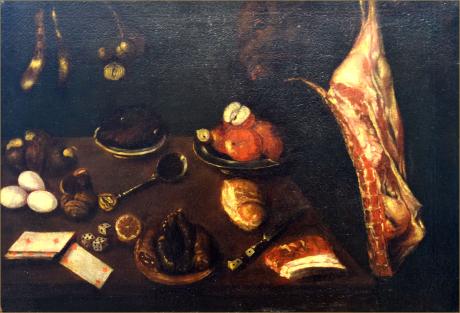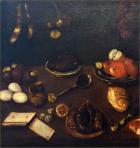Garlic, Onions, Sweet Chestnuts, Eggs, Playing Cards, Dice, Walnuts, Snails, Apples, Bread, Side of Lamb, Pork, Lemon , Sausages, Game Bird, Spoon and Knife and a Ceramic and Pewter Bowls.
Although still life painting was practiced in other European countries, only in Spain did it transcend its traditional status and rise to the same heights as other genres. Bodegón is the Spanish term for still life (from bodega, a storeroom or tavern). Taken more generally, bodegón refers to the representation of common objects of daily life, frequently including food. The still life image may contain piles of fruit, silvery fish lying on a plate, game birds hanging on a wall, or arrangements of flowers. Still lifes may also contain shiny pewter vessels, transparent glasses, woven rugs, books, jars, pipes, a writer’s inkwell, or the painter’s brush and palette. There are works that display the ingredients for an upcoming meal. All manner of inanimate objects are suitable subjects for still lifes, for the painter’s skill suddenly makes us aware of the artistic properties of ordinary things.
Still lifes can also carry a moral message, striking a serious, almost tragic note. The presence of a skull amid the beautifully painted objects is a reference to the transience of all things. These paintings, known as vanitas, are reminders of the vain emptiness of worldly things.
The emergence throughout Europe of the modern still life toward the end of the sixteenth century was a phenomenon related to rapidly evolving conditions in a society on the threshold of the modern age in politics, science, philosophy, and art. From that time on, no longer conceived as merely decorative or symbolic, the depiction of such things became the focus of a new relationship between the painter’s eye, his brush, and his mind. This approach seems to foreshadow the Cubist painters of the twentieth century, who used the potential of the still life to explore the very boundaries of art. Their concern with purely formal values was the ultimate extension of an attitude that, more than three hundred years before them, led another generation of radical young artists to paint the first such pictures without narrative content—works in which the perception of nature, the endurance of art, and the power of the artist were the principal subjects.
"Tell me what you eat, I will tell you who you are," boasted famed gastronome Jean Anthelme Brillat-Savarin (1755–1826) (1). A man of many interests, among them archaeology, astronomy, and chemistry, Savarin wrote treatises on economics and history, but his fascination with food was what most informed and entertained readers and followers in his native France and around the world. In nature and on the table, quite apart from its direct link to human survival, food has been an object of intrigue featured prominently in art throughout history. From ancient times and particularly during the development of genre painting in the Middle Ages and later, food—its appearance, abundance, or decay—has been a popular subject.
In 17th-century Spain, genre painting (scenes of everyday life) reached new heights with the work of Diego Velázquez. In a style reminiscent of Caravaggio, Velázquez created and popularized a new genre, the kitchen or tavern scene (bodegón), which showed peasants eating or preparing meals and the objects they used to assemble and serve them. These objects (still life), prominently displayed in realistic terms including their imperfections, assumed a life of their own, introducing a new naturalism in Spanish painting, which had been dominated by the ideal beauty of classical and academic themes.
Velázquez grew up in the cosmopolitan climate of Seville, southern Spain, along the banks of the Guadalquivir, an area also home to Cervantes, Lope de Vega, and other luminaries of the Spanish Golden Age. Like the great literature of that era, his art concerned itself with the life, culture, and traditions of the people. He apprenticed with influential biographer, theoretician, and artist Francisco Pacheco, who later wrote about his student: "After five years of education and training, I married him to my daughter, moved by his virtue, integrity, and good parts and by the expectations of his disposition and great talent" .
Soon a member of the Seville painters' guild, Velázquez moved from bodegón to portraits and was summoned to the court, where he received his first commission to paint King Philip IV, a discerning patron of the arts. He was appointed court painter, a position of great privilege, which gave him access to royal collections including paintings by the Venetian Renaissance master Titian, who greatly influenced the development of his style. The artist led a quiet life, interrupted only by his travels to Italy, sponsored by the king. During his first journey, he traveled with Flemish Baroque master Peter Paul Rubens, who was also influential in his artistic career.
"To go to Madrid to see the Velázquez" was Monet's wish near the end of his life . This wish, expressed in a letter to a friend, reflects the mystique associated with Velázquez' work and the breadth of its influence on all modern art schools, even if limited to 100 or so surviving works. His painting showed exceptional mastery of space and light and exuded naturalness and restraint, both in its objectivity and choice of colors, often browns and ochers. Velázquez was gifted with exacting technique and preferred to paint from life. In spite of his meticulous depiction of reality, he seemed more interested in the tensions between reality and appearance than in reality itself .
These concerns, apart from the underlying threat of decay through the relentless passage of time, a common theme in still-life painting, would be many, even if they were only limited to food. The 17th-century Spanish diet was known for its parsimony. A main concern in the common kitchen was the long-term availability of food. The safety of food, a more modern concern, was probably not on the mind of Velásquez' food preparers. Unlike our contemporary equivalents, they would have known little about the dangers surrounding food. Nor would they have understood Savarin, whose sensitive 18th-century palate might have recoiled at the sight of eggs poaching slowly in oil on a clay stove.



